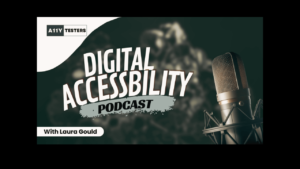A Comprehensive Guide to Accessibility Testing
Ensuring that your website or application is accessible to all users, regardless of their abilities, is not just good practice; it’s the law. Accessibility testing is the process of evaluating your digital content to make sure it can be used by people with disabilities. In this guide, we’ll take you through a step-by-step process for thorough accessibility testing.
Step-by-step process for thorough accessibility testing.
Step 1: Understanding Accessibility Guidelines – The Foundation of Inclusivity
To begin your quest for accessibility, you must grasp the fundamental principles set forth in accessibility guidelines, such as the Web Content Accessibility Guidelines (WCAG). These guidelines provide a framework that lays the foundation for an accessible digital world.
The famous retailer, Target, faced a lawsuit for accessibility issues on its website. This case underscores the significance of comprehending these guidelines to prevent legal troubles.
Step 2: Selecting Testing Tools – Your Arsenal for Success
In your arsenal for digital inclusivity, you must choose the right tools that align with your unique needs. The Accessibility Testing Tool box offers a diverse array of instruments, ranging from automated testing software to manual evaluations, each playing a distinct role in enhancing accessibility.
The automated tool “axe” from Deque Systems is an excellent choice for quick scans, helping organizations like Microsoft catch accessibility issues early in the development process.
Step 3: Automated Testing – A Swift Glimpse into Digital Accessibility
Automated tests provide a rapid but insightful overview of your website’s accessibility. They uncover common issues such as missing alt text, improper heading structures, or problematic color contrasts, serving as an excellent entry point for your accessibility journey.
eBay, A global e-commerce giant, leverages automated testing to continuously improve accessibility, ensuring that millions of users have an inclusive shopping experience. Know more about the Accessibility Test Approach Shifting Left for Inclusive Design
Step 4: Manual Testing – Uncovering Nuances Beyond Automation
While automated tools are invaluable, they can’t unveil all the subtleties of accessibility. Manual testing is the human touch that delves deep into your content, involving experienced accessibility experts who scrutinize your website with keyboard navigation, screen readers, and other assistive technologies.
The BBC, a renowned news organization, has an in-house accessibility test team that conducts manual testing to ensure its digital content reaches the widest audience.
Step 5: Usability Testing – The User-Centric Approach
Accessibility goes beyond technical compliance. it’s about creating a user-friendly experience. Users with disabilities become invaluable allies in usability testing, offering direct feedback on your site’s accessibility.
Microsoft includes individuals with disabilities in usability testing, refining their products to ensure inclusivity and user satisfaction.
Step 6: Documenting Issues – The Journal of Accessibility
Record-keeping becomes your journal of accessibility, documenting all the hurdles you encounter in both automated and manual testing. This detailed documentation is your treasure map, guiding you to address and prioritize accessibility fixes effectively.
Airbnb maintains a robust accessibility testing documentation system, helping them address issues promptly and efficiently.
Step 7: Prioritizing and Fixing Issues – The Path to Inclusivity
Not all issues are created equal. Prioritize them based on their impact and importance, focusing on critical issues that prevent access to essential content. Fixing these issues is your bridge to a more inclusive digital world.
The US Government focuses on critical accessibility issues to ensure public services are accessible to all citizens. What is a vpat and why is it important for accessibility
Step 8: Testing Again – The Quest for Perfection
After meticulously addressing issues, your journey isn’t over. Retest your website to ensure that the changes have been effective and that no new barriers have emerged.
The A11y project, a community-driven effort, continuously tests and retests its website to maintain high accessibility standards.
Step 9: Ongoing Maintenance – The Pledge of Digital Inclusivity
Accessibility is an enduring commitment. Regularly testing your website and content is the key to maintaining ongoing accessibility compliance and ensuring an inclusive digital environment.
Apple consistently updates and maintains accessibility features across its products, improving the digital experience for people with disabilities.
Conclusion
Accessibility testing is the heart of creating a digital environment where everyone can participate. By following this comprehensive guide, inspired by real-world examples and case studies, you’re not just meeting legal requirements, we’re making the digital realm more inclusive for all users.
Frequently Asked Questions
What is Accessibility Testing?
Accessibility testing ensures websites and apps are usable by people with disabilities, making it a legal and ethical requirement.
How Do I Start Accessibility Testing?
Begin by understanding guidelines like WCAG and choose the right tools for effective testing.
Why is Manual Testing Important for Accessibility?
Manual testing, conducted by accessibility experts, uncovers nuanced issues that automated tools may miss.



